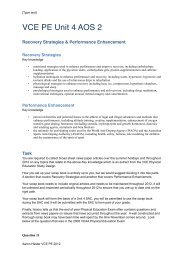Making & Breaking the Law - 9th Edition
Making & Breaking the Law - 9th Edition
Making & Breaking the Law - 9th Edition
- No tags were found...
Create successful ePaper yourself
Turn your PDF publications into a flip-book with our unique Google optimized e-Paper software.
Chapter 1 <strong>Law</strong> and society: an introduction 5<strong>the</strong> development of <strong>the</strong> legal system through a number of democratic processes. Theseprocesses include <strong>the</strong> electoral system, <strong>the</strong> provision of representative and responsiblegovernment, and <strong>the</strong> use of <strong>the</strong> jury system.In summary, <strong>the</strong> basic features of a law are:● <strong>the</strong> statement of a particular type of behaviour (this usually takes <strong>the</strong> form of ei<strong>the</strong>rprohibiting or regulating certain types of behaviour)● <strong>the</strong> provision of a sanction or remedy against anyone who violates <strong>the</strong> law● <strong>the</strong> formation of <strong>the</strong> rule by an authority recognised by <strong>the</strong> community.For example, <strong>the</strong> criminal law establishes expected behaviour by prohibiting certainactions. The criminal law is made by parliament, which is recognised by <strong>the</strong> communityas having <strong>the</strong> authority to make <strong>the</strong> law for <strong>the</strong> community as a whole. If a person doessomething that has been prohibited by <strong>the</strong> criminal law, <strong>the</strong>y will be punished by ei<strong>the</strong>rhaving <strong>the</strong>ir liberty restricted or a fine imposed.Sport—defining legal and non-legal rulesSome actions are only permitted within legally recognised games. For instance, <strong>the</strong> sportof boxing is strictly regulated and recognised organisations control boxing events. In aboxing match, punches are thrown with <strong>the</strong> intention of physical contact that may resultin harm. Outside <strong>the</strong> boxing ring <strong>the</strong>se same actions would come under legal rules, inparticular <strong>the</strong> law of assault.A boxer who agrees to take part in a legally recognised boxing match consentsto actions that would o<strong>the</strong>rwise be considered assault—provided that <strong>the</strong> match isconducted according to <strong>the</strong> rules of <strong>the</strong> sport of boxing. However, if a boxer wereto continue <strong>the</strong> fight after <strong>the</strong> end of <strong>the</strong> match, <strong>the</strong>n that person would be actingoutside <strong>the</strong> rules of <strong>the</strong> sport. In this case, <strong>the</strong> boxer may be subject to <strong>the</strong> legalrules of assault.There can sometimes be a fine line between legal and non-legal rules. Forinstance, <strong>the</strong> AFL requires all players to agree to abide by <strong>the</strong> AFL rules (non-legalrules). However, <strong>the</strong> agreements made by professional players to play AFL football arecontractual agreements (legal rules). Sometimes conflicts may arise between how <strong>the</strong>AFL applies rules and <strong>the</strong> principles of natural justice. In such cases, <strong>the</strong> courts may beasked to review decisions made by <strong>the</strong> AFL Tribunal.
6 <strong>Making</strong> and <strong>Breaking</strong> <strong>the</strong> <strong>Law</strong>A legal systemLegal rules differ from non-legal rules in that legal rules apply to <strong>the</strong> community asa whole. The legal system establishes procedures and institutions to make, administer,adjudicate and enforce <strong>the</strong> law in <strong>the</strong> community.In our legal system, law-making is primarily <strong>the</strong> responsibility of <strong>the</strong> CommonwealthParliament and <strong>the</strong> state parliaments. Courts (judges and magistrates) are responsible forinterpreting <strong>the</strong> meaning of <strong>the</strong> law and resolving disputes when it is claimed that <strong>the</strong> lawhas been broken (adjudicating).A variety of bodies has been established to enforce <strong>the</strong> law. For instance, <strong>the</strong> policehave <strong>the</strong> power to impose on-<strong>the</strong>-spot fines and <strong>the</strong> Department of Justice is a governmentdepartment responsible for <strong>the</strong> administration of justice. Because our legal system iscomplex, individuals may require assistance. Solicitors and barristers act as legal advisersand representatives for individuals in <strong>the</strong>ir dealings with <strong>the</strong> legal system.Types of lawsThe types of laws that we have in our society can be classified in a number of differentways. Whatever method we use to classify <strong>the</strong> law it is necessary to remember that, ina developed society such as ours, <strong>the</strong> law is complex and constantly changing. Newareas of law develop that may not neatly fit into existing categories. No one method of<strong>Law</strong>s can be classifiedaccording to <strong>the</strong> sourceor <strong>the</strong> type of <strong>the</strong>behaviour regulated.classification can cover all aspects of our law.By looking at <strong>the</strong> different ways of classifying <strong>the</strong> law we can start to appreciate <strong>the</strong>complexity of our legal system. The methods used to classify our laws include:● statute or common law (sources of law)● criminal or civil law (type of behaviour).The method that we choose to classify <strong>the</strong> law will reflect <strong>the</strong> purpose for which <strong>the</strong>classification is needed. For example, in Unit 3 we look at <strong>the</strong> law-making process. For <strong>the</strong>purpose of our study in this section we might want to classify <strong>the</strong> law according to <strong>the</strong> differentprocesses used to make <strong>the</strong> law (or sources of law). In Unit 4 we look at dispute settlementprocesses and procedures, and so may want to classify <strong>the</strong> law according to <strong>the</strong> differentprocesses used to resolve disputes. The dispute settlement processes and procedures differaccording to whe<strong>the</strong>r <strong>the</strong>y are for criminal or civil cases (or according to type of behaviour).In some cases, a wrongful act may involve more than one area of law. It may involveboth <strong>the</strong> rights of individuals, and <strong>the</strong> relationship between <strong>the</strong> individual and <strong>the</strong> state.This is often <strong>the</strong> case in car accidents. For instance,a speeding driver who fails to stop at a red light isguilty of a criminal offence. This behaviour constitutesa danger to <strong>the</strong> community as a whole. While drivingthrough <strong>the</strong> red light <strong>the</strong> driver collides with ano<strong>the</strong>rcar. As a result of <strong>the</strong> collision, <strong>the</strong> second car hasbeen damaged. The rights of <strong>the</strong> owner of <strong>the</strong> secondcar have been infringed. The driver of <strong>the</strong> second carcould recover this loss through <strong>the</strong> civil law by suing<strong>the</strong> o<strong>the</strong>r driver.
8 <strong>Making</strong> and <strong>Breaking</strong> <strong>the</strong> <strong>Law</strong>1.3 Types of tortsTypes of civil lawsCivil law includes both contract law and <strong>the</strong> law of torts. Contract law is concerned withlegally enforceable agreements made between individuals. Torts are concerned with <strong>the</strong>wrongful actions of one individual against ano<strong>the</strong>r individual. Some of <strong>the</strong> different typesof torts are set out in <strong>the</strong> following table.NegligenceNuisanceDefamationTrespassWhere <strong>the</strong> actions of an individual who has failed to exercise reasonable care adversely affectano<strong>the</strong>r individualWhere an individual interferes with ano<strong>the</strong>r’s enjoyment of <strong>the</strong>ir rightsWhere an individual damages <strong>the</strong> good name or reputation of ano<strong>the</strong>r through false ormisleading statementsWhere an individual physically interferes with ano<strong>the</strong>r person, <strong>the</strong>ir goods or landCriminal law and civillaw are dealt with usingdifferent procedures.It is important to understand <strong>the</strong> difference between <strong>the</strong> two types of behaviour. Criminallaw and civil law are dealt with by different procedures and have different consequencesfor <strong>the</strong> individuals involved. Criminal law is enforced by <strong>the</strong> police, <strong>the</strong> courts and <strong>the</strong>departments of corrective services. An individual who has been charged with a criminaloffence will be prosecuted by <strong>the</strong> state and, if found guilty of an offence by a court, willbe sanctioned. A sanction may include a fine, a community-based order or imprisonment.Civil law is concerned with <strong>the</strong> enforcement of an individual’s rights. In civil law, <strong>the</strong>individual affected by a breach of <strong>the</strong>ir legal rights is responsible for taking <strong>the</strong> case tocourt. If <strong>the</strong>ir case is successful, <strong>the</strong> court may award monetary compensation or issue acourt order to stop any fur<strong>the</strong>r infringement.We look in more detail at <strong>the</strong> difference between criminal and civil law in Unit 4.Tragic drowning: criminal and civilimplicationsON FATHER’S Day 2005 three boys died when RobertFarquharson drove <strong>the</strong> family car into a farm dam after anaccess visit. He claimed he lost control of <strong>the</strong> car when hesuffered a coughing fit and blacked out. The deaths of <strong>the</strong>boys had both criminal and civil implications.Farquharson was charged with murder. The prosecutioncase was that he deliberately drove his car into <strong>the</strong> dam andleft <strong>the</strong> boys to drown. In 2007 a jury found Farquharsonguilty of <strong>the</strong> murder of his three sons. He was sentenced tolife in prison. In April 2008 Farquharson lodged an appealagainst his convictions and sentence.In 2008 Mrs Cindy Gambino sued Farquharson, her formerhusband. She claimed that <strong>the</strong> deaths of her three childrenwere caused by his negligence in <strong>the</strong> driving, managementand control of his motor vehicle. She claimed that as a resultshe had suffered post-traumatic stress disorder and depression.Farquharson admitted negligence but argued that his actionsdid not cause Mrs Gambino’s injuries.Victorian Supreme Court judge Philip Cummins orderedFarquharson to pay <strong>the</strong> mo<strong>the</strong>r of his children $225 000 forgrief and suffering.In December 2009 <strong>the</strong> Court of Appeal quashedFarquharson’s conviction and set aside his life sentence. Hewas granted a retrial and was found guilty again in 2010.Robert Farquharson
Chapter 1 <strong>Law</strong> and society: an introduction 9Why do we need laws?The main function of law is to enable individuals to live peacefully toge<strong>the</strong>r. <strong>Law</strong>sallow individuals to work cooperatively towards meeting <strong>the</strong>ir needs for <strong>the</strong> benefit ofall members of <strong>the</strong> community. This is a concept known as social cohesion. The term‘cohesion’ means <strong>the</strong> act of uniting or sticking toge<strong>the</strong>r. <strong>Law</strong>s aim to ‘unite’ or ‘stick’society toge<strong>the</strong>r.To achieve social cohesion <strong>the</strong> law needs to be recognised or acknowledged by <strong>the</strong>community. The community will recognise <strong>the</strong> authority of <strong>the</strong> law if it:● sets out <strong>the</strong> expected behaviour of individual members● provides a means by which disputes can be resolved● reflects <strong>the</strong> values of <strong>the</strong> majority of <strong>the</strong> community● provides a means for changing <strong>the</strong> law.We need laws toestablish expectedbehaviour.We need laws to resolvedisputes.We need laws that reflect<strong>the</strong> shared values of <strong>the</strong>community.Establishing expected behaviourThe law helps keep society toge<strong>the</strong>r by prohibiting conduct that is disruptive. Prohibitionsinclude laws about aggressive behaviour, <strong>the</strong> use of property and <strong>the</strong> use of roads. Thesematters are all regulated by <strong>the</strong> criminal law. To ensure that members of society abide byits rules, society imposes punishments (sanctions) on those who violate <strong>the</strong>m. We look atthis in more detail in chapter 10.The rights of individuals are contained in <strong>the</strong> civil law. For example, <strong>the</strong> tort ofnegligence protects <strong>the</strong> rights of individuals to be free from harm that may result from <strong>the</strong>careless actions of ano<strong>the</strong>r. Where <strong>the</strong> rights of individuals have been violated, <strong>the</strong> lawprovides for a range of remedies to restore <strong>the</strong> individual to <strong>the</strong>ir original position.There is an array of remedies, because monetary compensation is not appropriatein all circumstances. For example, <strong>the</strong> law provides for court injunctions or orders thatrequire an individual to behave in a prescribed manner. Remedies provided in civil casesare examined in more detail in chapter 11.By stating <strong>the</strong> rights and responsibilities of individuals and society, <strong>the</strong> law makesexplicit <strong>the</strong> boundaries of behaviour. Therefore, each individual can know what isexpected and how to plan <strong>the</strong>ir interactions with o<strong>the</strong>r members of society.Resolving disputesThe law is necessary to provide for peaceful dispute resolution. Life in society wouldbe impossible if each individual was free to resolve a dispute by any method. The lawestablishes a range of dispute settlement bodies to deal with <strong>the</strong> variety of disputes thatmay arise in <strong>the</strong> community. These dispute settlement bodies include courts and tribunals.We will look at <strong>the</strong> role and function of courts and tribunals in chapter 6.The law also provides methods that can be used to resolve disputes. They include:● methods of dispute resolution (chapter 7)● <strong>the</strong> adversary trial (chapter 9)● <strong>the</strong> jury system (chapter 12).Reflecting valuesOne common element in all legal systems is <strong>the</strong> reliance of law on a set of values that areshared by that society. These values are a collection of beliefs and attitudes about whatis right or good. The values that are shared by <strong>the</strong> community form <strong>the</strong> basis of what isright or good in law.Throughout <strong>the</strong> world, religious beliefs have strongly influenced <strong>the</strong> developmentof law. Australia is a diverse community consisting of numerous religious, cultural andethnic groups that uphold a variety of values. However, <strong>the</strong>re are some values that arecommon. For example, <strong>the</strong> value that we place on human life is upheld by <strong>the</strong> majorityof people in our community. The law upholds this value by making it an offence to takeano<strong>the</strong>r person’s life (<strong>the</strong> offence of murder). The law also recognises that <strong>the</strong>re are
10 <strong>Making</strong> and <strong>Breaking</strong> <strong>the</strong> <strong>Law</strong>some circumstances in which it may be excusable to take ano<strong>the</strong>r’s life. The right of eachindividual to use reasonable force for self-protection is recognised by <strong>the</strong> laws relating toself-defence.It is difficult for <strong>the</strong> law to preserve <strong>the</strong> values of all members of society. In order forus to live toge<strong>the</strong>r as a group, it is necessary for <strong>the</strong> law to uphold <strong>the</strong> values that arepredominant. For example, <strong>the</strong> rules on marriage may vary from one religion to ano<strong>the</strong>r.However, <strong>the</strong> law recognises <strong>the</strong> prevailing value that marriage should be <strong>the</strong> union ofone man and one woman. In Australia, only monogamous, heterosexual marriages arelegally binding. This does not necessarily reflect <strong>the</strong> values of all groups and individualsin society. Same-sex couples may strongly disagree with <strong>the</strong> idea that marriage can existonly between one man and one woman.The law reflects a variety of values:● <strong>the</strong> way in which members of society relate to o<strong>the</strong>rs (social values)● <strong>the</strong> fundamental beliefs about right and wrong (moral values)● <strong>the</strong> rights of individuals in <strong>the</strong> economic system (economic values)● <strong>the</strong> rights of individuals in <strong>the</strong> organisation of our legal system (political values).How a country interprets <strong>the</strong>se values will vary according to historical, religious andcultural influences.Aboriginal law and valuesABORIGINAL law forms a part of <strong>the</strong> complex rules thatgovern <strong>the</strong> rights and responsibilities of Indigenous peoplein Australia. The Aboriginal system of law—customaryor traditional law—contains some sophisticated elementsthat reflect <strong>the</strong> cultural tradition of Indigenous people. Forinstance, this system allows informality in dispute settlement,conciliation procedures and participation in <strong>the</strong> administrationof justice, and stresses <strong>the</strong> rehabilitation of offenders.Such dispute settlement methods are still evolving in moredeveloped legal systems. Although European contact haslessened <strong>the</strong>ir influence in many regions, some Indigenousgroups in isolated areas still follow <strong>the</strong> traditional way of life.Aboriginal law is both sacred and secular. Sacred lawis considered <strong>the</strong> more important and involves many secretrites. Sacred law is linked to <strong>the</strong> Aboriginal concept of <strong>the</strong>Dreamtime, and many aspects of this have not been revealedto non-Aboriginal people. Secular law contains <strong>the</strong> body ofrules with which members of an Indigenous community areexpected to comply.Traditional Indigenous groups have <strong>the</strong>ir lawmen who areresponsible for <strong>the</strong> interpretation of <strong>the</strong> sacred law. Sacredlaw also imposes additional sanctions in matters such as <strong>the</strong>ft,assault and adultery. Substantial authority rests with <strong>the</strong> eldersof <strong>the</strong> community, and leadership is vested with a council ofelders. The Pitjantjatjara are one such community, consistingof about 4000 people spread over <strong>the</strong> Nor<strong>the</strong>rn Territory,Western Australia and South Australia. They believe that <strong>the</strong>law has always existed and will exist until <strong>the</strong> end of time.The strength of <strong>the</strong> Aboriginal legal system can be seen by<strong>the</strong> fact that it has bound a people toge<strong>the</strong>r and maintained astable lifestyle for more than 40 000 years.
Chapter 1 <strong>Law</strong> and society: an introduction 13The price of justiceM & B ReviewHow much does it cost to prosecute shoplifters? Consider <strong>the</strong> case of a 16-year-old youth whowas on probation when he stole a pack of chocolates worth $1.79.Police investigated <strong>the</strong> case, prosecution and defence lawyers were employed, youth workerswere appointed and court time set aside to hear <strong>the</strong> case. The estimated cost to taxpayers—up to$10 000.Does <strong>the</strong> prosecution of this case justify <strong>the</strong> costs? Experts claim that we must addressjuvenile crime before it escalates into more serious offences when <strong>the</strong>se children become adults.A successful prosecution results in a sanction being imposed to rehabilitate <strong>the</strong> offender.31 February 2015M & B Review 31/2/15SourceCostsIssueProsecution of a shoplifter wasestimated to cost up to $10 000SummaryIs it too costly to take cases to court?Legal question●●●●Make a start on your issues folio with <strong>the</strong> following exercise.Collect two articles illustrating aspects of criminal law.Collect two articles illustrating aspects of civil law.Collect two articles discussing proposed changes to statute law.Collect one article discussing an aspect of judge-made law.Annotate your articles—as illustrated in <strong>the</strong> example above.
















